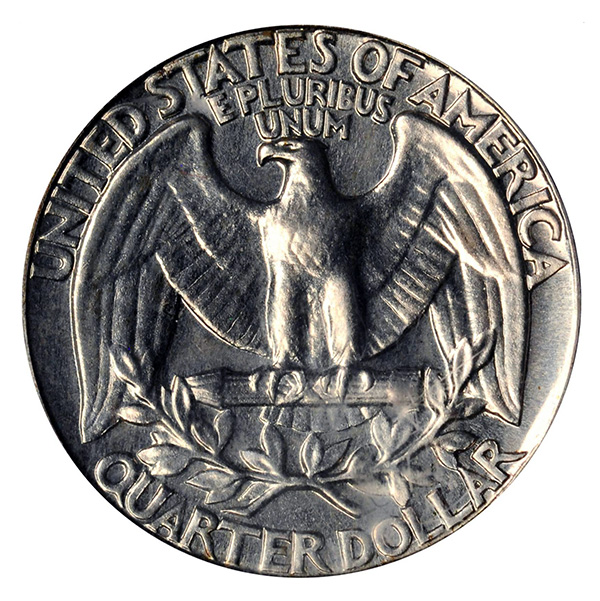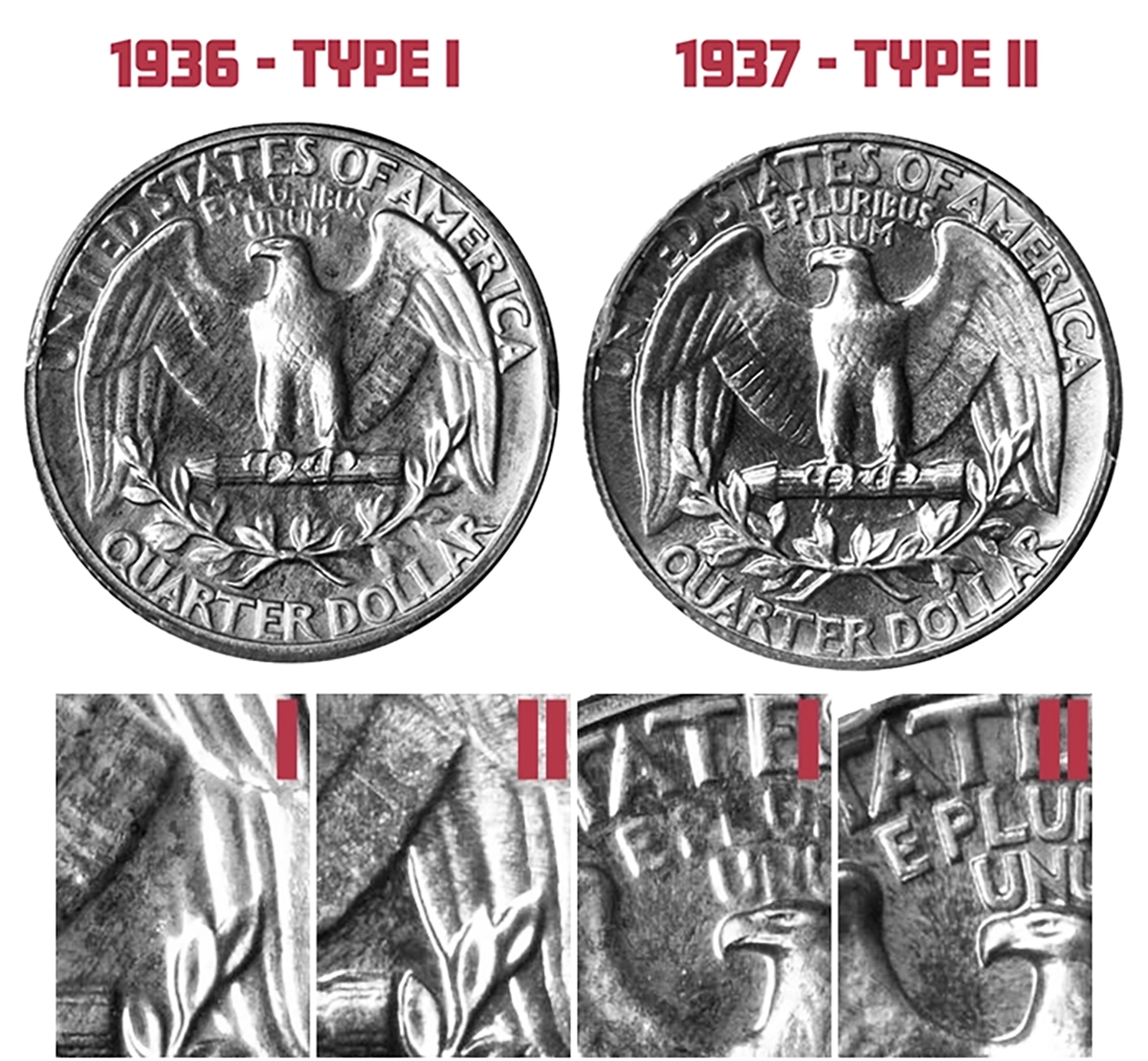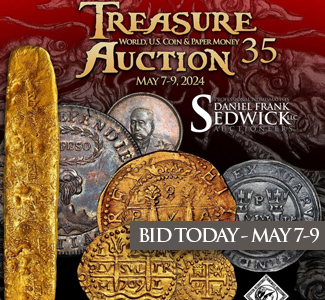
Intended to be a circulating commemorative coin honoring the bicentennial of the birth of America’s first president, the Washington quarter as originally designed was struck from 1932 to 1998, save for a two-year run in 1975 and 1976 when the coin’s reverse was swapped out for the “drummer boy” design of Jack Ahr.
The backstory behind the Washington quarter is the stuff of myth and intrigue.
Anticipating the release of a half dollar honoring Washington, the Commission of Fine Arts (CFA), in collaboration with the George Washington Bicentennial Commission, held a contest to find a winning design for the coin. The competition called for the artists to base their portrait of George Washington on the Jean-Antoine Houdon (1741-1828) bust of Washington. Houdon’s elegantly-executed sculpture was derived, in part, from a 1786 life mask of the future first president.
According to a contemporaneous report in the January 1932 issue of The Numismatist, 99 designs were submitted. Of those, five finalists were sent back to the artists for revision. A committee convened to review the revised designs and selected the designs of sculptor Laura Gardin Fraser. By law, the Secretary of the Treasury had final say, and despite the protests of the CFA and the Bicentennial Commission, Secretary Andrew Mellon chose the designs of John Flanagan.
This led to a bitter public back and forth between partisans on the side of Fraser and the Treasury – the extent of which has been blown out of proportion over the years by scholars and experts in the numismatic field.
The controversy did lead to the delay of the coin’s issue, as the February 22 target release date came and went. The first coins were struck near the end of May, or perhaps on or about June 1. The coin entered into circulation on August 1, 1932.
Flanagan’s obverse design features a left-facing bust of George Washington. On the reverse, Flanagan renders America’s heraldic eagle in Art Deco style.
The Washington quarter series can be broken down as follows:
- Silver Heraldic Eagle era (1932, 1934-1964)
- Clad Heraldic Eagle era (1965-1974)
- Bicentennial Quarter (1975-1976)
- Clad Heraldic Eagle era resumed (1977-1998; Spaghetti Hair 1989-1998)
- 50 State Quarters era (1999-2008)
- U.S. Territories & D.C. reverses (2009)
- America the Beautiful era (2009-2021)
- Washington Crossing the Delaware reverse (2021)
- American Women Quarter era (2022-2025)
- Semiquincentennial Quarter (2026)
- Youth Sports Quarter era (2027-2030)
The Washington quarter was struck in .900 silver from 1932 through 1966. .900 silver quarters struck in 1965 and 1966 bear are antedated 1964. The last “1964” quarter was struck in January 1966. The first copper-nickel clad quarter was struck in August 1965. Copper-nickel clad has been the circulating coin composition of the quarter dollar since August 1965.

The 1937 Proof Washington Quarter
The 1937 Washington quarter Proof is noteworthy because it marks the beginning of the modern method of Proof production at the United States Mint using separate dies for Proofs and business strikes. Before 1937, it was standard practice for the Mint to sequester and polish standard dies for Proof strikings. This proved to be unsatisfactory for Flanagan’s quarter design, as it did not hold up well after being polished and retreated. According to late numismatic researcher and Washington quarter die expert Herb Hicks, the Washington quarter Type B reverse originates in 1937 to deal with this deficiency. The new master hub was created by promoting an edited working Hub. This new reverse featured reinforced letters and a lowered field.


The official figures provided by the U.S. Mint cast the total number of 1937 Washington Proof quarters distributed at 5,542 pieces. This often gets reported as the issue’s mintage or even the mintage of the 1937 Proof Set, but this is not the case. While this may come as a surprise to modern collectors accustomed to the sale of Proof Sets from the Mint, Proof issues struck from 1936 to 1942 could be purchased individually as well as in sets. Therefore, the maximum number of 1937-dated sets that could have been constructed is no greater than the total distribution of the Proof coin with the lowest distribution.
Numismatist Roger W. Burdette’s excellent research on the topic of 1936 to 1942 Proof issues is further illuminating. Burdette estimates a mintage of approximately 7,390 pieces, with some number of these coins being of insufficient quality. Burdette claims net sales for the issue to be 5,505 pieces struck from five obverse and six reverse dies. All known Proof quarters of this issue are of the Type B reverse variety.
* * *
Market Data and Noteworthy Specimens
Top Population: PCGS PR-68 (12, 3/2024). NGC PF-69 (1, 3/2024). CAC PR-68 (3:0 stickered:graded, 3/2024)
1937 Proof Washington quarters were struck with a fully brilliant finish. No coins are known to exist with any degree of cameo contrast.
As of March 2024, PCGS, NGC, and CAC have record 3,060+ grading events of the 1937 Washington quarter in Proof. These figures are somewhat misleading as they do not take into account resubmissions and crossovers. Suffice it to say, a majority of the true Choice and Gem examples of this issue that have come to market within the past 30 years have made their way to one or both of these grading services, perhaps on multiple occasions. The state of preservation for the issue runs the gamut from impaired, cleaned, and hairlined to nearly flawless – with the latter being decidedly rare given the coin’s age and the technology collectors have had at their disposal to preserve coins over the years.
Many Gem-quality coins survive, but Gems do not make up the majority of the extant population. A midrange piece, graded Proof 65 by either service, is now available for about $300.
The PCGS population of Proof 68 coins has increased five fold since 2005, when the population was a paltry two coins. The initial two were #2591961 (now CAC-approved) and the Daniel D. Biddle coin (#22040483). The Biddle coin would go into Tom Mershon’s registry set.
That number held until about 2015, when a third example was sold by Heritage (#25226177). After this point, there was a four year drought of auction appearances for the 1937 Proof Washington quarter in top pop grades.
At the time of this writing (March 2024), a total of 12 Proof 68 coins have been certified by PCGS. We believe that at least nine have appeared at auction, bringing prices ranging from a low of $5,040 in 2020 to a high of $18,400 in 2005. The low number appears to be an outlier as other Proof 68s consistently bring twice that amount. All of these coins exhibit an expected degree of toning, but none of the coins would quality for what one might call vivid toning. It is difficult to determine eye appeal simply looking at two dimensional coin photographs or slab scans.
NGC reports 25 grading events at 68 and one in 69. The sole PF-69 in an NGC holder has blue and green toning and brought $9,200 at a 2009 Heritage Auction. The NGC PF-69 was last auctioned by Heritage in 2009. It is a virtually flawless coin, with only a tiny planchet flaw to the left of Washington’s mouth.
CAC has stickered three coins in PR-68.
- NGC PF-69 #371589-004: Heritage Auctions, July 31, 2009, Lot 735 – $9,200. Tiny planchet flaw to the left of mouth. Blue, Gold, and Orange toning. Flawless.
- PCGS PR-68 #45540681: GreatCollections, August 28, 2022 – View Lot. Wispy gold toning.
- PCGS PR-68 CAC #43044208: Heritage Auctions, January 13, 2022, Lot 3411 – $11,700. Pale blue and red hue.
- PCGS PR-68 #44245977: GreatCollections, December 19, 2021 – View Lot. Wispy streaks of blue, green, gold, and purple.
- PCGS PR-68 CAC #41886148: GreatCollections, June 6, 2021 – View Lot; Red, gold, and green toning. Light “spot” to the left of Washington’s eye.
- PCGS PR-68 CAC #25363124: Heritage Auctions, October 16, 2020, Lot 3372 – $5,040. Splashes of purple, blue, and gold toning throughout. Orange spot to the right of the hair bow.
- PCGS PR-68 CAC #2591961: Heritage Auctions, December 9, 2011, Lot 3807 – $17,825; “The MKJ Collection, Part II”, Heritage Auctions, June 6, 2013, Lot 4494 – $16,450. Heritage Auctions, October 15, 2020, Lot 3059 – $15,000. Vivid blue toning highlights on the obverse.
- PCGS PR-68 #38163890: GreatCollections, November 17, 2019 – Viet Lot.
- PCGS PR-68 #25226177: Heritage Auctions, April 23, 2015, Lot 5051 – $7,637.50. Blue and gold toning around the periphery.
- PCGS PR-68 #22040483: “Daniel D. Biddle Collection, Part One”, Heritage Auctions, September 23, 2005, Lot 3056 – $13,800. Daniel D. Biddle on insert. Heritage Auctions, September 18, 2008, Lot 914 – $11,500. Re-encapsulated. Tom Mershon Collection on insert.
- PCGS PR-68 #8336476: Heritage Auctions, July 28, 2005, Lot 6221 – $18,400. Old Green Holder. Certification number no longer active.
* * *
Design
Obverse:
Sculptor John Flanagan’s obverse design features a left-facing portrait of George Washington based on the Jean-Antoine Houdon bust of 1786. LIBERTY wraps around the top of the coin, above Washington’s hair. The date 1937 wraps around the bottom, below Washington’s bust truncation. To the left of Washington is the national motto IN GOD WE TRUST.
Reverse:
A heraldic eagle, rendered in Art Deco style is perched atop a sheaf of arrows. The arrows and the eagle’s head are facing left. Two sprays of olive branches form a U-shape wrapping around the bottom of the eagle. Wrapping around the top of the coin is the legend UNITED STATES OF AMERICA. Below that, the motto E PLURIBUS UNUM. Wrapping around the bottom of the coin, the denomination QUARTER DOLLAR is inscribed.
Edge:
The edge of the 1937 Proof Washington quarter, like all Washington quarters, is reeded.
Designer
Born in New Jersey in 1865, John Flanagan lived in New York for most of his life. He began working with Augustus Saint-Gaudens in 1884 at the age of 20 and quickly became a well-known sculptor and medallic artist in his own right. Saint-Gaudens made introductions for Flanagan at the United States Mint. While the Washington quarter was his sole numismatic design, Flanagan designed numerous famous medals and sculptures, including the official medal of the 1915 Panama-Pacific International Exposition, the official Verdun medal gifted to France by the U.S. Government, and the 1924 bust of Saint-Gaudens. Flanagan was also a member of the American Numismatic Society (ANS).
Coin Specifications
| Country: | United States of America |
| Year Of Issue: | 1937 |
| Denomination: | Quarter Dollar (USD) |
| Mint Mark: | None (Philadelphia) |
| Mintage: | 5,542 |
| Alloy: | 90% Silver, 10% Copper |
| Weight: | 6.25 g |
| Diameter: | 24.30 mm |
| Edge: | Reeded |
| OBV Designer: | John Flanagan |
| REV Designer: | John Flanagan |
| Quality: | Proof |
* * *




